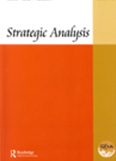Iran-Pakistan Relations: Political and Strategic Dimensions
Iran-Pakistan relations have had a distinct characteristic over the past five decades and Islamabad’s clandestine transfer of nuclear technology and materials to Iran underlines its significance. Political and strategic imperatives have formed the basis of their close relationship despite divergence of interests and political outlook on regional and global issues. Both the countries have tried to reconcile the differences and consolidate their ties.
- Shah Alam
- October 2004





